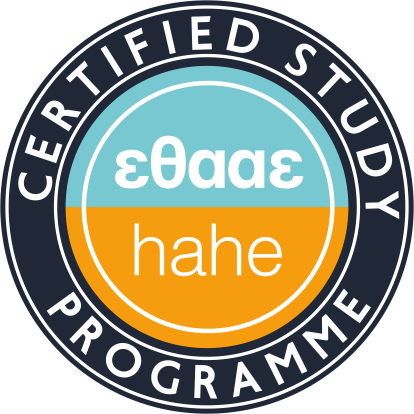Translation English ‒ Greek I
Teaching Staff: Kelandrias Panagiotis
Course Code: EN-1216
Gram-Web Code: ΜΕ1501Θ
Course Category: Specific Background
Course Type: Compulsory
Course Level: Undergraduate
Course Language: English / Greek
Semester: 1st
ECTS: 3
Total Hours: 2
Erasmus: Not Available
Description of the Translation as a goal-setting activity, intercultural and interpersonal interaction, and text-producing action. The texts delivered contain a heavy cultural load and they are chosen from British, Irish and/or American web pages. They analysed by spotting the linguacultural differences between the Greek and the foreign reality and are translated following the translating instructions delivered to the students together with each ST and the application of specific rules and strategies.
Upon successful completion of the course, the students will be able to:
- understand that translation is a goal-oriented activity determined by the communicative purpose
- understand that translation is a decision-making process where, apart from the translator, other agents participate (initiator, commissioner, user, and receiver of the translation) who influence the content and the form of the translation
- understand that the translation product is the result of the interaction of the above factors
- understand the importance of the translation brief both as an influencing factor of the translation process and product and as a tool of the translation quality assessment
- understand that translation problems and functions are text-inherent features
- understand that the application of translation rules and strategies depends on the particularities of each assignment
- search and use information and documentation sources related to the thematic of the source-text (ST)
Week 1: Delivery of the first ST. Brief presentation and discussion on its content. Analysis of the translation brief and the purpose of the translation. Presentation and analysis of the different categories of translation problems and text functions. Delivery of parallel English and Greek texts. The students are asked to: a) study the parallel texts to acquire some basic knowledge on the thematic of the ST and get acquainted with their language and textual conventions, b) to study the ST and spot and classify its translation problems and functions, c) to propose eventual solutions of the translation problems, and d) evaluate the feasibility of the translation brief.
Week 2: Discussion of the tasks (a) to (d) above and evaluation of their results from the students and the instructor. Presentation and discussion of the translation rules and macro- and microstrategies. Following this discussion and the evaluation of the results of the tasks (a) to (d) above the students are asked a) to re-evaluate their solutions, and b) make a draft ST translation focusing on the macrostructure of the ST.
Week 3: Assessment of the intertextual coherence of the draft translation to the ST and spotting of eventual mistranslations. Once the functional relevance between the ST and the target text (TT) is ascertained the students are asked to look for solution on the microstructure level applying the translation microstrategies that have already been discussed.
Week 4: The students present and explain their solutions on the target-text (TT) microstructure level. The proposed solutions are evaluated and reviewed if necessary. Analysis of the notion of translation error and mistake with the aim to be constructively used by the students. Based on the discussion so far, the students are asked to produce a final TT.
Week 5: Evaluation of the TT through the assessment of its intratextual coherence to the language and textual norms and the expectations of the TT audience. Discussion and re-evaluation of the process that led to the production of the TT. Delivery of the second ST and assignment same as in Week 1 above.
Week 6: Same as in Week 2 above. Moreover, the students are asked to start keeping a translation diary where they will describe the steps that they follow to accomplish their weekly tasks.
Week 7: Same as in Week 3 above. The students present their translation diaries to discuss and evaluate the process they followed.
Week 8: Same as in Week 4 above. The students present their translation diaries to discuss and evaluate the process they followed.
Week 9: Same as in Week 5 above. The students present their translation diaries to discuss and evaluate the process they followed. Delivery of the third ST and assignment same as in Week 1 above.
Week 10: Same as in Week 2 above. The students present their translation diaries to discuss and evaluate the process they followed.
Week 11: Same as in Week 3 above. The students present their translation diaries to discuss and evaluate the process they followed.
Week 12: Same as in Week 4 above. The students present their translation diaries to discuss and evaluate the process they followed.
Week 13: Same as in Week 5 above. Overall assessment of the process followed throughout the semester.
Nord, Christiane (2014). Translation as a Purposeful Activity (translated and adapted in Greek by Simos P. Grammenidis and Despina Lambrou). Athens: Diavlos.
Munday, Jeremy (2002). Translation Studies. Theories and Strategies (transl. Aggelos Filippatos). Athens: Metaihmio.
Face-to-face.
The teaching method is based on the functional approaches of translation and, specifically, a) on the Skopostheorie and b) the Theory of Translational Action.
It also combines the process-oriented and the product-oriented approach. The learning method is mostly student-centred, and it is based a) on the principle of the Zone of Proximal Development, b) the admission that knowledge is rather discovered than constructed, and c) the interchanging role of the teacher from coordinator to instructor and vice versa.
The teaching material is digitally available through the Open eClass platform.
The students are evaluated through written examinations at the end of the semester. They are asked to translate into Greek an English text of about 400 words following specific translating instructions. The content of the text is similar to the content of one of the texts elaborated throughout the semester
The evaluation criteria are those defined in the beginning of the semester. Specifically, the translation will be evaluated according to its compliance with the translating instructions and its intertextual and intratextual coherence.
Back
Undergraduate
Secretariat
Galinos Building (1st floor)
Corfu, GR-49132
Open to the public:
Mon, Wed, Fri: 11am - 1pm
Tue, Thu: 11am - 1pm (Erasmus+)
 E-Class Platform
E-Class Platform
 eSecretariat
eSecretariat
 Webmail
Webmail
 Learning Material Management
Learning Material Management
 Internship Portal
Internship Portal
 Library
Library





 Translation English ‒ Greek I
Translation English ‒ Greek I
